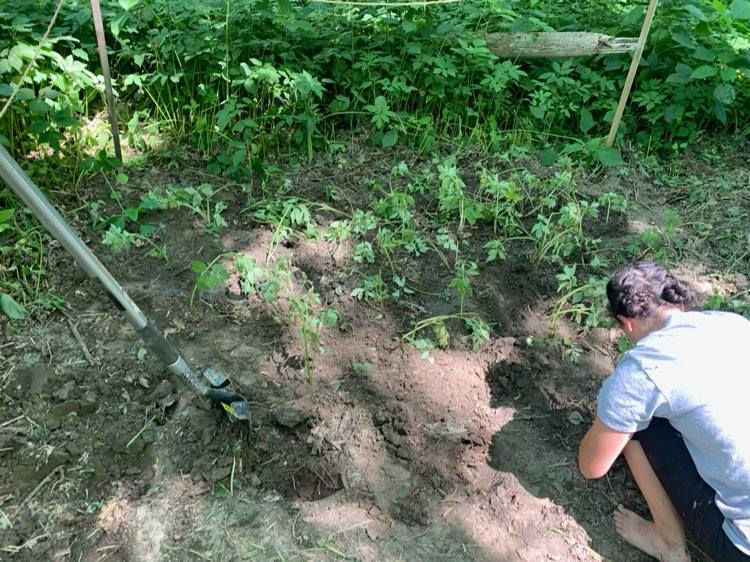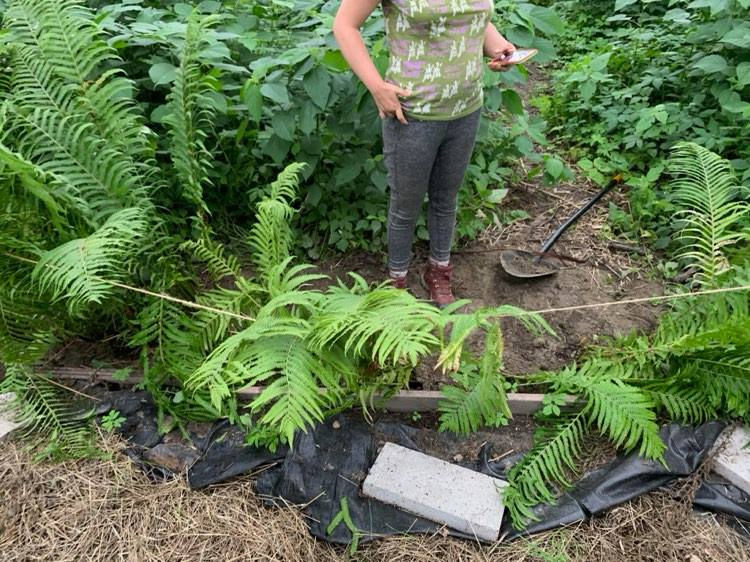Go(u)t Weeds?
- marjoriemcwilliams
- Jul 28, 2021
- 6 min read
Updated: Jul 28, 2021
Our first brain child of this summer was developing an experiment to inform best practices surrounding goutweed eradication. Goutweed is a small, low growing plant with leaves that are comprised of three groups of three leaflets and can be green or variegated. Upon my first exploration of the Intervale through an invasive species lens, I was more than a little horrified by the amount of goutweed that plagues Caulkins Loop Trail, extending deep into the woods in dense patches, uninterrupted except for the stinging nettle that coexists by growing slightly above it. My first reaction is one of doom and gloom. I envision myself spending my summer working around the clock on my hands and knees, systematically uprooting individual goutweed stems, submerged in a sea of leafy greenness, while being continuously victimized by the looming nettle leaves. This daunting image dissolved once I learned that the rate of regrowth makes hand weeding an impractical option. Most farmers and landowners have had extremely limited success in managing goutweed, making it quite the sore subject among those acquainted with this plant. To know it is to hate it, apparently! Niki Jabbour, author of three gardening books, describes it as “the cockroach of the botanical world.” I like to think of it as more of a “wild child” in honor of it’s admirably untameable and rebellious qualities but regardless it has proven to be so tenacious that the common advice to gardeners is to simply move their gardens rather than try and challenge it.
Luckily Libby, Nora and I have the time and resources to expend our infinite energy into projects that have a high probability of being futile. Experimenting with goutweed seemed like a natural place for us to start. In fact, I’d go so far as to say that the importance and beauty of our internship is that we are able to wholeheartedly tackle the kinds of projects that are so tricky and low reward that full time staff cannot justify working on them. While these kinds of projects are not doing our self-esteem any favors, I like to remind myself that what doesn’t work is an important step in pursuit of best practices. It may feel as though we are blindly orchestrating a spectacular shit show destined to end in catastrophic, not to mention embarrassing, failure but this seems to be the nature of experimentation! We are bolstered by reassurance from seasoned staff members that there isn’t much we could do to make the goutweed situation worse.

With that promising blessing and peace of mind, we selected four plots, three at The Intervale and one at the Ethan Allen Homestead and paired them with four corresponding treatments. Each plot is 10x10 ft and sectioned off with twine and stakes. The three plots at The Intervale are clustered together to the side of Caulkins Trail, several yards into the dense thicket of goutweed and stinging nettle. The site at the Ethan Allen Homestead is visually similar, just off the River Loop Trail. These sites were primarily chosen for their density of goutweed, with the aim of limiting the damage to native plants. Most unfortunately, the interspersed stinging nettle could not be shielded from harms way and is subject to our interference. Visiting our sites requires a bit of bushwhacking, a fact made exponentially worse by the aforementioned stinging nettle which dedicatedly capitalizes on every opportunity to target the merest sliver of exposed skin and make us simultaneously irritable and miserable. I hope by now you have gleaned that while we have complicated views on villainizing invasive plants, we have no qualms about defiling the good name of Stinging Nettle! Despite several nettle sting induced meltdowns that briefly threatened the harmony of our small yet orderly task force, we’ve managed to persevere and implement four different methods. The four methods being tested are
Smothering: Using compression and lack of sunlight/water to stress goutweed (Intervale)
Solarization: Using sunlight to create an unfriendly environment for goutweed (Intervale)
Competition: replanting with Virginia Waterleaf, Ostrich Fern and Sensitive Fern (Intervale)
Natural “herbicide”: a solution of vinegar, salt and clove oil to superficially stress above ground vegetation (EAH)
We chose these methods because we were curious about them and thought they had potential, not because we thought we would have instant success (although that would have been well received). At best, we are striving for the lowest impact, lowest cost practice that can be easily implemented by farmers, gardeners and land managers struggling with monocultures of goutweed. All of these methods except the natural herbicide require first digging/pulling the goutweed site in its entirety, to rid the soil of as many viable roots as possible. In order to visually delineate our patches and, as a bonus, strip the nettle of it’s stinging powers, we choose to begin with a weed whacker. Our difficulties operating the weed whacker represents the largest dip in my self esteem to date. At least a half hour was spent yanking the line to bring the whacker to life. A variety of different angles, speeds and levels of aggression were tested to no avail. All of my creeping self doubt of being under qualified was confirmed by an oily worn out power tool! It was an unspoken agreement that we could not and would not be asking for help in this scenario. Fortunately, Nora developed the magic touch and away we whacked! That’s the beauty of a trio - we all have our strengths! Libby knows how to turn plants into helpful balms and ointments, Nora can identify bird calls as well as operate machinery and I excel at reminding everyone when it’s time to eat lunch. Everyone benefits. With this victory under our belt, we stood in the midst of our herbaceous bloodbath of beheaded plants, and began using our hands and shovels to extract the roots. Despite the magnitude of the task, it felt like a victory everytime I unearthed a thick mass of goutweed’s spidery ribosomal roots. This part of the project took several hours over the course of several days.

In addition to testing goutweeds resilience via smothering, solarizing, competition and homemade potions, we wanted to experiment with containment strategies. If we can’t eradicate goutweed, the next best approach would be to understand how to successfully prevent goutweed from spreading. We dug 8 inch trenches along the perimeter of the plots which we filled with wood barriers (for a more in-depth understanding of the unique challenges of wood and a very enjoyable pun, please refer to the post entitled What WOOD You Do?). We placed wood barriers around the smothering site and the solarization site, planning to visually assess the spread of goutweed outside the perimeters of these sites in contrast to the unguarded “competition” site. This element of the experiment was added with the sentiment that the result may be devastatingly negligible but it wouldn’t hurt to try. Ah, the freedom of working against cataclysmic odds! One of the challenges of conducting field experiments is the overwhelming number of confounding factors. In the spirit of experimentation, we have tried to address as many of these factors as possible while also recognizing that they are inevitable and uncontrollable. Each test plot presented us unique challenges and required some thoughtful discussion. The specific details of each test site’s implementation are plentiful, full of misguided ideas, spontaneously changed plans and surprising successes, the chronicles of which we will be publishing in the near future to fully document our process for individual sites.

So far we are recognizing that most of these methods have already proven to be far more labor intensive than most operations would be willing to emulate. On the other hand, our limited experience and unintended knack for doing things the hardest way possible could potentially be contributing to the arduous nature of the work. We are still hopeful that we can extract something useful from this experience to pave the way for others who may be better equipped to execute our findings efficiently. That being said, the hardest pill to swallow about invasives management is that it is truly a long play and the satisfaction of seeing lasting results is a dangling carrot that only those who commit years to the cause will achieve, even with all the tools at their disposal. At this point we are simply hoping to find the most effective way to harass and traumatize the goutweed to the point where it succumbs out of pure exasperation and fatigue. This requires an immense amount of patience and faith, two of my least developed personality traits! To compensate, I use self-deprecating humor as a coping mechanism and consume a laughable amount of stress reducing herbal tea. Stay tuned for our deep dive into each method, the process, the tools, the confounding factors, the observations and of course, the emotional rollercoaster.



Comments